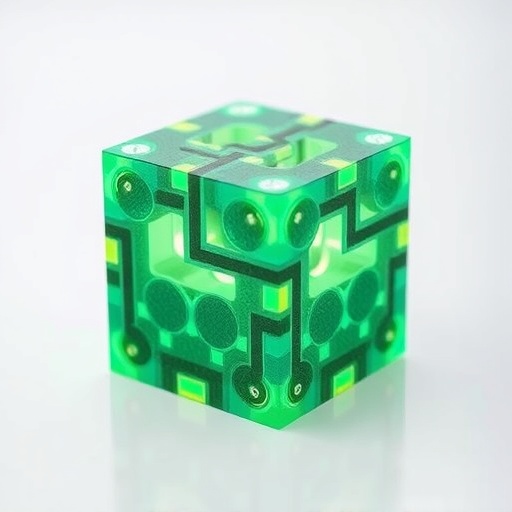In the relentless pursuit of energy harvesting technologies that seamlessly integrate with the human body, the development of materials exhibiting both exceptional thermoelectric performance and elasticity remains a formidable challenge. Traditional thermoelectric materials, although capable of converting thermal gradients into electrical power, have largely been rigid or, at best, flexible without exhibiting the true elastic properties necessary for long-term, comfortable wearable applications. This frontier was significantly advanced by the recent breakthrough reported by Liu et al., unveiling one of the first n-type thermoelectric elastomers that combines outstanding stretchability and mechanical resilience with impressive thermoelectric efficiency.
The allure of thermoelectric generators (TEGs) for wearable and soft bioelectronic devices lies in their ability to harvest body heat and convert it directly into electricity, thereby potentially powering implants, sensors, or personal temperature regulators without the need for bulky batteries. Flexibility in these materials aids in conforming to complex curved surfaces, such as skin, but elasticity is what ensures durability and sustained performance under repeated stretches and deformations typical in daily movement. Prior to this work, achieving high thermoelectric performance in materials that are truly elastomeric—capable of recovering from strains exceeding 100%—had remained elusive, primarily due to a trade-off between mechanical compliance and electrical functionality.
The innovation by Liu and colleagues stems from their clever integration of several crucial strategies into a single material system. At its core, their design hinges on a bulk nanophase separation approach, which differentiates distinct domains within the polymer matrix, enabling both robust mechanical properties and enhanced charge transport pathways. This architecture is complemented by thermally activated crosslinking that judiciously stabilizes the polymer network without sacrificing elasticity, maintaining the material’s rubber-like recovery even at large strains of up to 150%. Importantly, the researchers introduced targeted n-type doping, which imparts high electrical conductivity to the semiconducting polymer nanofibrils dispersed within the elastomeric framework.
.adsslot_dBmfEGcXWR{ width:728px !important; height:90px !important; }
@media (max-width:1199px) { .adsslot_dBmfEGcXWR{ width:468px !important; height:60px !important; } }
@media (max-width:767px) { .adsslot_dBmfEGcXWR{ width:320px !important; height:50px !important; } }
ADVERTISEMENT
Conventional wisdom in organic thermoelectrics had held that embedding insulating polymers to induce elasticity would invariably dilute the active semiconducting components, undermining electrical conductivity and therefore device efficiency. This study challenges and overturns that dogma by demonstrating that the choice of elastomer and dopant chemistry can be fine-tuned to not only preserve but actively enhance electrical conductivity. The n-doping process produces heavily doped polymer nanofibrils that are uniformly wrapped by elastomeric chains, creating effective percolation networks for charge transport while simultaneously suppressing phonon-mediated thermal conductivity.
This dual effect—of increased electrical conductivity coupled with decreased thermal conductivity—is pivotal for optimizing the dimensionless figure of merit, ZT, which governs thermoelectric efficiency. Liu et al.’s thermoelectric elastomers achieve ZT values rivalling or even surpassing those of some flexible inorganic materials, marking a significant step forward in the performance limitations that have traditionally held organic thermoelectrics back. These metrics were maintained or even improved under mechanical deformation, a testament to the material’s remarkable stability and resilience.
From a structural perspective, the thermoelectric elastomer’s morphology is characterized by the formation of uniform nanofibrillar networks intimately interfaced with the elastomer matrix. This microscopic ordering ensures that upon stretching, the conductive pathways remain intact or self-recover, preventing loss of electrical performance. The thermally activated crosslinking fortifies the polymer scaffold, providing an elastic backbone that withstands cyclic strains without hysteresis or mechanical fatigue. Such properties open transformative possibilities for wearables where devices must flex, stretch, and compress with body movements over extended periods.
The broader implications of this research touch upon the future of self-powered wearables and soft bioelectronics. With thermoelectric generators rendered truly elastic, devices can better conform to diverse and dynamic surfaces such as skin, joints, or even internal organs. This conformality is critical for intimate thermal contact, maximizing energy harvesting efficiency from subtle temperature gradients between human skin and the surrounding environment. One could envision new generations of personal temperature management systems—garments or patches that generate electricity from body heat while adapting seamlessly to body contours and movements.
Moreover, the ability to harness n-type materials with high performance complements existing p-type thermoelectric elastomers, enabling full thermoelectric modules that produce more efficient power outputs through complementary charge carrier types. Historically, n-type organic thermoelectrics have lagged behind their p-type counterparts, making this breakthrough particularly notable. This balance enhances the practical applicability of thermoelectric devices, especially in scenarios demanding light weight, elasticity, and mechanical robustness.
The approach detailed by Liu et al. not only marks a technological leap but also provides a generalizable materials platform. By elucidating the critical role of dopant distribution, nanophase separation morphology, and thermal crosslinking kinetics, their work paves the way for future materials engineering efforts to tailor mechanical and electrical properties in harmony. This insight is expected to catalyze innovation beyond thermoelectrics alone, influencing fields such as flexible electronics, stretchable sensors, and energy-harvesting textiles.
Yet, the research also points to challenges and questions for subsequent investigation. The long-term stability of dopants under physiological conditions, scalability of synthesis methods, and integration strategies for practical device manufacturing remain areas for further exploration. Control over the interfacial interactions between the elastomeric and semiconducting phases could unlock even higher thermoelectric figures of merit or multifunctional devices that combine sensing and power generation.
In conclusion, the paradigm shift introduced by the development of intrinsically elastic n-type thermoelectric elastomers heralds a new era for wearable energy technologies. By marrying high-performance thermoelectric functionality with true elastomeric mechanical behavior, this advancement sets the stage for innovative self-powered devices capable of stretching, bending, and recovering while delivering reliable electrical output. The work transforms the landscape of organic thermoelectrics and offers promising pathways toward ubiquitous, comfortable, and efficient wearable electronics powered solely by the heat of the human body.
As this technology evolves, the potential impacts span medical monitoring, fitness tracking, environmental sensing, and thermal regulation, all benefiting from materials that feel and behave like skin yet generate power sustainably. The findings underscore the critical value of interdisciplinary materials design in solving grand challenges at the interface of chemistry, physics, and engineering—a testament to the power of inventive molecular architecture in shaping tomorrow’s technologies.
Subject of Research: Elastic n-type thermoelectric materials for wearable energy harvesting devices.
Article Title: n-Type thermoelectric elastomers.
Article References:
Liu, K., Wang, J., Pan, X. et al. n-Type thermoelectric elastomers. Nature (2025). https://doi.org/10.1038/s41586-025-09387-z
Image Credits: AI Generated
Tags: advancements in energy harvestingbody heat energy conversionchallenges in thermoelectric materialsdurable wearable technologyelastic properties in electronicsenergy harvesting technologiesflexible bioelectronic deviceshigh performance thermoelectricsmechanical resilience in elastomersn-type thermoelectric elastomersstretchable thermoelectric materialsthermoelectric generators for wearables






